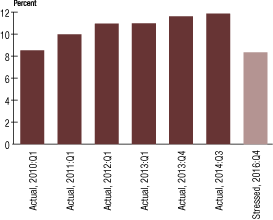Dodd-Frank Act Stress Test 2015: Supervisory Stress Test Methodology and Results
- Errata
- Preface
- Executive Summary
- Background on Dodd-Frank Act Stress Testing
Executive Summary
The Dodd-Frank Wall Street Reform and Consumer Protection Act (Dodd-Frank Act) requires the Federal Reserve to conduct an annual stress test of BHCs with $50 billion or more in total consolidated assets and all nonbank financial companies designated by the Financial Stability Oversight Council (FSOC) for Federal Reserve supervision. The Board adopted rules implementing this requirement in October 2012.
For this year's stress test cycle (DFAST 2015), the Federal Reserve conducted supervisory stress tests of 31 BHCs.
This report provides
- background on Dodd-Frank Act stress testing;
- details of the adverse and severely adverse supervisory scenarios used in DFAST 2015;
- an overview of the analytical framework and methods used to generate the Federal Reserve's projections, highlighting notable changes from last year's program; and
- the results of the supervisory stress tests under adverse and severely adverse scenarios for the BHCs that participated in the DFAST 2015 program, presented both in the aggregate and for individual institutions.
The adverse and severely adverse supervisory scenarios used in DFAST 2015 feature U.S. and global recessions. In particular, the severely adverse scenario is characterized by a substantial global weakening in economic activity, including a severe recession in the United States, large reductions in asset prices, significant widening of corporate bond spreads, and a sharp increase in equity market volatility. The adverse scenario is characterized by a global weakening in economic activity and an increase in U.S. inflationary pressures that, overall, result in a rapid increase in both short- and long-term U.S. Treasury rates.
In conducting its supervisory stress tests, the Federal Reserve calculated its projections of a BHC's balance sheet, risk-weighted assets (RWAs), net income, and resulting regulatory capital ratios under these scenarios using data provided by the BHCs and a set of models developed or selected by the Federal Reserve. As compared to DFAST 2014, the Federal Reserve enhanced some of the supervisory models to incorporate more detailed data. These changes are highlighted in box 1. Specific descriptions of the supervisory models and related assumptions can be found in appendix B.
The results of the DFAST 2015 projections suggest that, in the aggregate, the 31 BHCs would experience substantial losses under both the adverse and the severely adverse scenarios.
Over the nine quarters of the planning horizon, losses at the 31 BHCs under the severely adverse scenario are projected to be $490 billion. This includes losses across loan portfolios, losses from credit impairment on securities held in the BHCs' investment portfolios, trading and counterparty credit losses from a global market shock, and other losses. Projected net revenue before provisions for loan and lease losses (pre-provision net revenue, or PPNR) is $310 billion, and net income before taxes is projected to be -$222 billion.
As illustrated in figure 1, in the severely adverse scenario, the aggregate tier 1 common capital ratio would fall from an actual 11.9 percent in the third quarter of 2014 to a post-stress level of 8.4 percent in the fourth quarter of 2016.
In the adverse scenario, projected losses, PPNR, and net income before taxes are $314 billion, $501 billion, and $178 billion, respectively. The aggregate tier 1 common capital ratio under the adverse scenario would fall 110 basis points to its minimum over the planning horizon of 10.8 percent before rising to 11.7 percent in the fourth quarter of 2016.

Source: FR Y-9C, FR Y-14A, and supervisory estimates under the severely adverse scenario.
